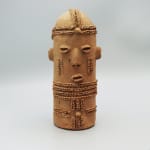Bura Terracotta Head , Twelfth to Thirteenth Century AD
Terracotta
24 x 11.5 x 10 cm
9 1/2 x 4 1/2 x 4 in
9 1/2 x 4 1/2 x 4 in
ES.7096
Further images
-
(View a larger image of thumbnail 1
)

-
(View a larger image of thumbnail 2
)

-
(View a larger image of thumbnail 3
)

-
(View a larger image of thumbnail 4
)

-
(View a larger image of thumbnail 5
)

-
(View a larger image of thumbnail 6
)

-
(View a larger image of thumbnail 7
)

-
(View a larger image of thumbnail 8
)

-
(View a larger image of thumbnail 9
)

Almost nothing is known about the Bura people, who inhabited northern Nigeria and parts of Mali. They appear to have originated in the First Millennium AD, though their main archaeologically...
Almost nothing is known about the Bura people, who inhabited northern Nigeria and parts of Mali. They appear to have originated in the First Millennium AD, though their main archaeologically excavated site, Nyamey, dates to the Fourteenth and Fifteenth Century AD. We have no idea about Bura religion, about their social structure, or even their language. We do, however, have a number of Bura sculptures which have survived from what in Europe would be the Mediaeval Period. Most of these come from a few burial sites in present-day Niger. The expanse and density of these sites has taken archaeologists by surprise, and indicates that these little-known people had complex burial practices and abnormally large (from an African perspective) population densities. This would seem to suggest a highly urbanised culture, with populations centred on city sites which are now lost to the ages. Most Bura burials consist of an upturned urn, sometimes with figural imagery. The most elaborate of these images consisted of equestrian sculptures, while the simplest were highly abstract heads.
This figure falls into the latter category. It is a semi-phallic Bura head, made from the rich red clay of the Niger valley, is of a form known from a number of Bura burials. Phallomorphic sculptures are among the most characteristic of the Bura artistic output, and may have an important fertility function, conflating the male reproductive imperative with the output of the fields on which the Bura relied to support their large population. The inclusion of such phallomorphic figures among burials would seem to indicate a Bura belief in an afterlife, or rebirth, which was intimately connected to agricultural fertility. Such beliefs are a commonplace in Africa, and have their roots as far back as the Egyptians, whose god Osiris both ruled the underworld and taught humankind farming.
This figure is of a cylindrical shape with a domed top. Around the dome are raised decorations which may indicate hair, which would appear to be shaved into particular patterns which may indicate social status or religious belief. The facial features are carefully modelled, with a pinched nose, sleepy almond-shaped eyes, and an open mouth with prominent lips. Along the body are further raised and incised decorations which may represent clothes or, more likely, an elaborate scarification. Scarification is a common practice among African tribes, especially in the Niger-Nigeria-Mali region. The practice is indeed ancient, and there is no reason to think that scarification was not practiced as far back as the First Millennium AD.
This figure falls into the latter category. It is a semi-phallic Bura head, made from the rich red clay of the Niger valley, is of a form known from a number of Bura burials. Phallomorphic sculptures are among the most characteristic of the Bura artistic output, and may have an important fertility function, conflating the male reproductive imperative with the output of the fields on which the Bura relied to support their large population. The inclusion of such phallomorphic figures among burials would seem to indicate a Bura belief in an afterlife, or rebirth, which was intimately connected to agricultural fertility. Such beliefs are a commonplace in Africa, and have their roots as far back as the Egyptians, whose god Osiris both ruled the underworld and taught humankind farming.
This figure is of a cylindrical shape with a domed top. Around the dome are raised decorations which may indicate hair, which would appear to be shaved into particular patterns which may indicate social status or religious belief. The facial features are carefully modelled, with a pinched nose, sleepy almond-shaped eyes, and an open mouth with prominent lips. Along the body are further raised and incised decorations which may represent clothes or, more likely, an elaborate scarification. Scarification is a common practice among African tribes, especially in the Niger-Nigeria-Mali region. The practice is indeed ancient, and there is no reason to think that scarification was not practiced as far back as the First Millennium AD.








